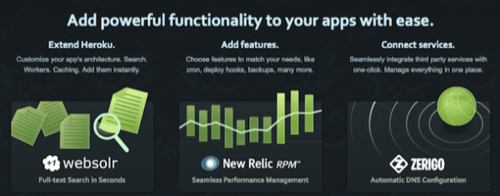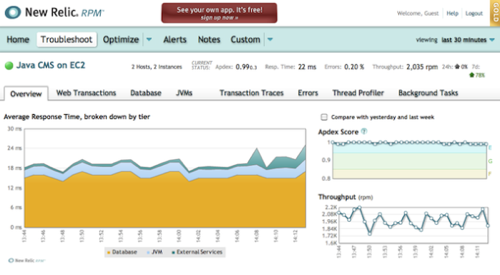Heroku is a platform that offers an effective join of the best parts of scaling cloud infrastructure with simple but great tools for immediately provisioning Ruby applications. Last week, at the Under the Radar event, where Heroku is a alumni, the company announced that they are nearly at 60,000 applications – marking a growth rate of over 1,000 new applications hosted weekly.

In this quick analysis, we’ll review Heroku and New Relic as two pieces of cloud infrastructure that helps web sites perform to service level agreements even the developer can love.
$ sudo gem install heroku – or – Getting Started is Easy
Feel like impressing the boss?
Tell ’em you can transform that whiteboard sketch into an working web application in two weeks.
That is what some inspired Ruby developers are doing. Some significant enterprises are giving it a shot. We found this list of enterprises that are known to have a Ruby application in production.
So, the boss says “do it“
What do you do next? If the answer needs to be “now”, Heroku can fit in nicely as a place to launch your application without having to bring new technology or skills into the organization.

Heroku’s ruby platform lives on top of Amazon Web Services. The company sells a unit of computing called a Dyno, and bundles packages like the Ronin that are comprised of compute plus storage packages. All of Heroku’s offerings come with infrastructure curation build ton top of EC2, S3 and a host of Amazon Web Services.
Shown here is a snapshot of the Heroku Add-ons, partners the company offers to developers.

It offers simplicity to the developer in the way the platform is bundled into Ruby. It has simple documentation that almost makes it fun to flip through architecture diagrams. And, it uses a model for add-ons that both promote the partner and make it easy to on-board. For example, when buying the popular Ruby application performance tool, New Relic for use in Heroku, the billing comes directly through Heroku’s console and process.
Recently, Heroku teamed up with NorthScale to introduce a memcache implementation to Heroku customers. Now, memcache is a command away, provisioned in your Amazon infrastructure cloud, all tuned and orchestrated by Heroku. All of the sudden, the cloud looks even smarter for developers scaling Ruby.
New Relic Saves the SLA
So, your app is ready, it looks exactly like your team wants it to. Is it ready for production launch? This can be an important time, and more and more often, developers are turning to tools like New Relic to test for application bottlenecks as part of the acceptance process.
Sometimes, however, something is missed, and an application starts getting reports of “slowness”, perceived or real. New Relic is ready to offer help, where you can tune your application, or do a quick two-minute install and troubleshoot.
Here is a demonstration application company hosts with a sample application.

New Relic has become a dominant application performance management tool. Its services provide a way to tune Ruby (and now Java) applications and report on a number of factors such as application performance satisfaction.
The company has chosen to guide users towards simplifying the way SLAs are defined by implementing Apdex (Application Performance Index) which buckets application SLAs into three buckets, “satisfying” “tolerable”, and “frustrating”.

By taking this approach to judging performance, the company moves users to the true experience of the web application instead of the raw metrics. What this boils down to is business owners being able to pinpoint where they need to be satisfied with the overall application performance.
Ruby hosting in the cloud is catching on. With cloud offerings for real-time performance tuning and scaling up in the cloud a whole new door for growth with the language and adoption for the enterprise.
Platforms like Heroku and tools like New Relic are bending the time-honored boundaries of Information Technology. The old joke “quality, time, cost – pick any two” is about meeting reality face-to-face. Yet, we wonder if Ruby in the cloud will offer the opportunity to break the rules of reality and let developers have it all.
With commands such as “heroku scale memcache” directly near our fingertips, it may be time to claim a future where quality, time, and cost are joined as one.





















